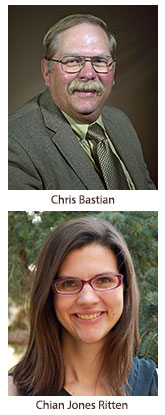
Contact Us
Institutional Communications
Bureau of Mines Building, Room 137
Laramie, WY 82071
Phone: (307) 766-2929
Email: cbaldwin@uwyo.edu

UW Economists Question Current Anti-Money Laundering Measures
Published December 09, 2021

It’s not that professors in the Department of Agricultural and Applied Economics at the University of Wyoming are involved in money laundering, but they are -- sort of.
Economists Chian Jones Ritten and Chris Bastian, and their partner, Professor Emeritus Owen Phillips in UW’s College of Business, shouldn’t have to worry about FBI agents bearing handcuffs on the UW campus this holiday season.
But policymakers directing money laundering enforcement might be interested in the trio’s research into the best ways to reduce illegal trade.
Their findings, published in the research journal PLOS ONE in November, suggest concentrating law enforcement efforts at the point of sale is more effective to reduce illegal market activity than seizing laundered profits. Their article, titled “The relative effectiveness of law enforcement policies aimed at reducing illegal trade: Evidence from laboratory markets,” can be read here.
Their economic laboratory experiments showed illicit trade is reduced nearly 32 percent when law enforcement is focused at the point of sale. That may be oversimplified, but think of the Wyoming Highway Patrol seizing illegal products en route to a deal or market.
“Given all of the emphasis currently on policy addressed at money laundering and stopping money laundering, I was somewhat surprised we found that law enforcement aimed at money laundering is really not that effective,” says Jones Ritten, an associate professor in the department. “But, when we thought about it from an economic perspective, that wasn’t surprising at all.”
Phillips had received training on investigating money laundering and approached Bastian about the topic.
“It really started out more focused on money laundering but, between Chian, Owen and me, it grew into a broader topic on policy looking at illegal products,” says Bastian, a professor in the department.
Those markets could include illegal drugs, organs, wildlife and even fraudulent food products.
Their previous work had already studied factors that affect privately negotiated or less developed markets. The new work was an extension of how people negotiate and the outcomes they expect, Jones Ritten says.
“If there are risks of law enforcement, how does that affect behavior?” Jones Ritten asks. “So it might sound really out there, but it really is similar to the lab work we’ve already done. What we’re really thinking about is on a much larger scale -- large producers who may have entities in many countries and many regions. And, so, we’re talking about large-scale buyers and sellers of these illegal markets.”
Thirty-six lab experimental sessions had 288 participants bargaining along the production-trade-laundering cycle, with a risk of seizure at various points.
“We had to assign what the risk was,” Bastian says. “There is no empirical evidence to tell us what the rate of seizure actually is.”
They assigned a 20 percent chance of being caught.
“I think the question in the real world is, ‘Is that 20 percent above or below what we actually see in these product markets?’ And that’s data we just don’t have,” Bastian says. “But I think the reality is, if you were somebody involved in that market, our research points to if we can give you the perception the risk is relatively high, that may alter your behavior.”
He jokes that he’s not going to conduct field research to find out.
Results showed behaviors in the market were not what models suggested. The 32 percent reduction was surprising.
“The magnitude of the reduction in trade is what was really different,” Jones Ritten says. “We found that law enforcement in these areas was much more effective than theory alone would have predicted.”
People respond to these risks in a much more drastic fashion than models suggest, she says.
“It’s especially the sellers who respond so much more drastically than we ever expected them to, and the amount of reduction that they have and the amount of product they produce and trade,” Jones Ritten says.
That’s good for law enforcement, she says.
“Their objective is to reduce the trade and production, and we found that these risks associated with these types of markets and law enforcement create a larger reduction than we had originally thought,” she says.
Turns out criminals react the same to the risk of their products being seized as having to pay taxes.
“After we started looking at results, in my mind, it started to fall in line with research in other areas related to taxes and how people respond to those types of costs when they’re doing business,” Bastian says. “They start looking at the tax as a cost of business.”
Contact Us
Institutional Communications
Bureau of Mines Building, Room 137
Laramie, WY 82071
Phone: (307) 766-2929
Email: cbaldwin@uwyo.edu

